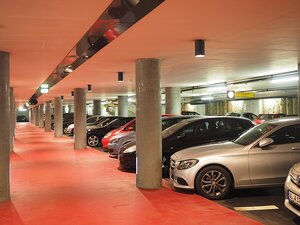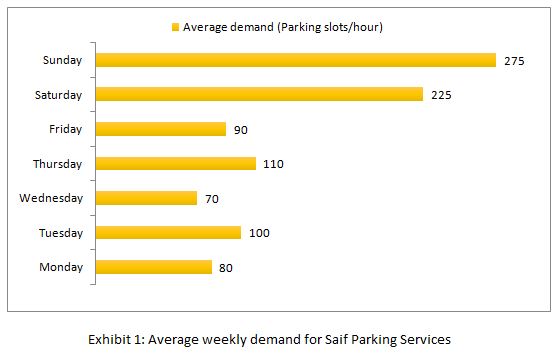Case Type: Growth Strategy
Case Style: Interviewer Led
Industry: Parking Services
Case Type: Growth Strategy
Industry: Parking Services
Case by Boston Consulting (BCG)
Our client, Saif solutions owns and runs a parking space in Dallas, Texas near a busy commercial region. It currently operates a parking space of 1 acres which can accommodate approximately 150 cars.
Owner of Saif Solutions, Mr. Saif has recently met with an opportunity where he has an option to buy an adjacent 0.5 acres of land to extend his capacity with another 80 spaces for car parking.

Mr. Saif has engaged us to help him in making this decision on whether he should or not grab this opportunity. What would you recommend?
Practice with Case Partner: Format
The case study falls under the sub-category of cost benefit analysis within the broader Growth strategy framework. Candidate is expected to evaluate the present business model of Saif Parking Solutions and make a recommendation on whether expansion to a new facility can boost in growth for them.
Additional information (To be provided only on request)
- Acquiring additional land will cost $4 mn. Developing it into the parking space will add that value by another $1 mn
- Mr. Saif has sufficient cash reserves to fund this investment. (i.e. assume cost of capital to be 0)
- This is the only parking space available in the neighborhood within the radius of 10 miles
- The expected rate of return for Mr. Saif on his investment is 13%
Instructions for driving the Case Interview
Candidate is expected to solve this case by answering following questionnaires, led by the interviewer/ case partner.
Question 1: Provide an approach & highlight the factors that you would consider in this decision making.
Notes for Interviewer: Candidate must understand and highlight the use case for conducting a Net Present Value (NPV) analysis for solving this case. For doing so, he will have to figure out the variables like required initial investment and compare it with the present value of the annual operating incomes for future years from the new facility.
Candidate is expected to present an appropriate framework involving atleast the following factors to complete this study –
- Understanding Parking Space Market
- Understanding Company’s capabilities & Business model
- Competitors Analysis
- Investment Analysis
APPROACH
The expected additional revenue in coming years from the increased capacity needs to be compared with the land acquisition & development cost combined to understand the profitability of the project. Needless to say, a NPV (Net Present Value) analysis will be ideal for this situation.
![]()
FACTORS
Understanding parking space market
- What is the current demand for parking space in the locality? How does the demand-supply equation fits in for this market?
- Are we currently losing customers due to space constraint?
- What is our current average utilization rate? Operating hours?
- How has been the utilization growth rate for the existing space for years?
- What is the average parking price per hour?
- Does acquiring additional space brings in any kind of operational synergies for the client?
Competitors Analysis
- Are there any other parking spaces nearby? How are they priced? Any distinction in parking spaces as offered by us v/s our competitors?
- What happens if we don’t acquire the land? Does it goes to one of our competitor who might extend his capacity and challenge us in future?
Company’s Capabilities
- What would be the source of funds? Company reserves or debt? Opportunity cost for the funds?
- Does the current leadership has enough bandwidth to manage the additional space? Or, Do we need to hire an outsider for the job?
- What is the current operating margins from the existing parking spaces?
Investment analysis
- What is the land acquisition cost? Land development cost? Require more equipment?
- What is the additional operating cost? Require more staff?
- What is the return that Mr. Saif is expecting on his investment? Anything specific?
Factors discussed above and under possible answer section are expected to be highlighted by a good candidate without much support. The list provided is a must but not exhaustive. Brownie points for candidates who are able to add other meaningful heads to the list.
Question 2: Share the following exhibit with the Candidate and ask him to analyze the market potential of the new facility.

Additional information with exhibit (To be provided only on request)
- Car parking charges per hour at present is $2.5
- Operation timings for Saif parking services are from 10:00 am to 10:00 pm everyday
- Operating expenses for Saif parking services at present is pegged at 60%. This percentage is expected to be same for the new facility as well.
- Saif’s revenue from parking services has been growing steadily at a rate of 10% Year-on-Year
Notes for Interviewer: Candidate is expected to perform NPV analysis here. Following summarizes the results of the expected calculations –
- Additional revenue could be generated only on weekends by catering the current unmet demand.
- All the unmet demand is expected to be available at the new facility as there is no other parking service nearby
- Utilization rate for the new facility is expected to be 100% over weekends
- Annual additional revenue from the new facility = $249,600
- Additional cash flow (or, Profit margin) resulting from new facility annually = $99,840
- NPV for this project = [Free Cash flows/(Discount rate – Growth rate)] – Initial investment = -$1,672,000
- Free Cash flow = $99,480; Discount rate = 13%; Growth rate = 10%; Initial Investment = $5 mn
Insights from the exhibit can be summarized as below –
- Over regular weekdays, hourly demand for car parking slots is pretty much stable and is found to be in the range of 70-110. For simplification of calculations, we can say that, average hourly demand for any weekday is 90 parking slots per hour
- Sharp spike in demand can be witnessed over weekends. This demand is in the range of 225 – 275. Again for simplification, we can assume the average hourly demand for weekends to be 250 parking slots per hour
From the problem statement, we also know that Saif’s current parking facility can host a maximum of 150 cars per hour. Therefore, on weekdays; Saif parking services is running its operations with an average utilization rate of 60% and for weekends this utilization rate goes all the way to 100% along with the unmet demand.
With unmet demand, certainly there is enough room to think about expansion, provided it makes sense quantitatively.
Considering the average utilization rate calculated above; we can clearly say that additional revenue from the new facility could only be generated on weekends by catering the unmet demand. Since there is no other parking facility nearby; we can safely assume that all the unmet demand is expected to be available at the new facility.

Basis the NPV value, an average candidate may conclude that the investment is not fruitful for the client and thus should not be made. In such a scenario; the interview can be concluded here. It is needless to say that the analysis performed by the candidate was incomplete and not upto the mark.
However, a good candidate will look for other options to make this acquisition possible, as there is plenty of unmet demand in the market. One such recommendation could be to increase the parking charges to $3.5 per hour on weekends for the new facility. Using the same calculation approach described above, results can be summarized as below –
- Annual additional revenue from the new facility = $349,440
- Additional cash flow (or, Profit margin) resulting from new facility annually = $199,680
- NPV for this project = [Free Cash flows/(Discount rate – Growth rate)] – Initial investment = $1,656,000
- Free Cash flow = $199,680; Discount rate = 13%; Growth rate = 10%; Initial Investment = $5 mn
Note: Operating expenses for the new facility in this case will still be the same as calculated in the earlier case i.e. $149,760. Increasing per hour price won’t affect operating expenses of the client’s new facility
A good candidate will conclude here stating that the client should go ahead with the acquisition only if they are comfortable increasing the per hour parking charges for its services at the new facility. Parking charging to the tunes of $3.5 or above per hour is likely to bring the desired return on investment for the client.
Question 3: Parking facilities in the city are regulated by the state authorities. At present, the local authorities have capped the maximum parking charges at $3 per hour. What would be your stand and recommendation in this case?
Notes for Interviewer: Candidate is expected to perform a similar calculation approach (as performed earlier) with $3 per hour parking charges. Following summarizes the results of this calculation –
- Additional annual revenue in this case would be = $299,520
- Operating expenses to remain same at $149,760 (as calculated in the first case)
- Annual additional cash flow (or, Profit margin) from the new facility in this case = $299,520 – $149,760 = $149,760
- Net Present Value (NPV) = -$8,000
This is a trick question to differentiate between a good and an excellent candidate. Basis NPV calculations, a good candidate may conclude that client should not go ahead with the investment because of this regulatory capping requirement in place.
However, an excellent candidate would still recommend client to go-ahead with this investment, justifying it with the following reasons –
- Saif parkings can increase the parking charges per hour to $3 for their existing facility as well. Thus maintaining the overall profitability and return from its entire services.
- If Saif Parkings do not expand; there are good chances that some other competitor lands up in the space, thus providing damage to the existing revenue of the client.
Question 4: Ask the Candidate to summarize his recommendations.
A good recommendation should suggest client to go-ahead with the investment and highlight its benefit both quantitatively and qualitatively. An excellent recommendation will also include risks involved in the process along with an action plan.
Mr. Saif, owner of Saif Parking solutions was exploring the opportunity of whether to invest in an additional parking space as an expansion to his current facility or not.
Considering the market variables and NPV analysis, I would recommend him to go-ahead with this investment & expansion plan. However, to get the expected returns from this investment; he is advised to increase the prices for his parking services to a value of $3 per hour (from a current price of $2.5 per hour). This will ensure that he meets his financial goals along with retaining his monopoly in the business & the region.
Plan of Action (Next Steps)
- Mr. Saif should try to better negotiate this deal and bring down the acquisition & development cost of land to a value under $5mn
- Selection of contractors required for developing the land
- Marketing & Promotion Planning
Risks involved
- Competition might outrun Mr. Saif to offer a better deal for this land
- Increased prices might result in customer dis-satisfaction & trigger protest

